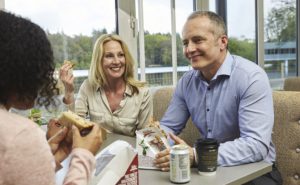HEALTHIER APPROACH
According to recent research by Bartlett Mitchell, workplace wellbeing is more important to organisations than product and service innovation. Its report, ‘Reimagining Catering post COVID’, found that although technology will be integral to enhance customer experience, it should not replace great food and service.
The challenge for employers will be to maintain the delivery of healthy food choices while balancing wider concerns such as maintaining social distancing and infection control.
The vending sector has responded to the demand for healthier options via automated dispensers. AVA research found that over a third of new product development from leading food-to-go operators in 2020 was new vegan products. Another key trend the AVA predicts will continue to rise in 2021 is the over-arching move towards healthy snacking products.
Evans explains that for Sodexo: “Wellbeing is going to remain high on consumers’ agenda. We are still very focused on food that is nutritious and sustainably sourced, even when we are delivering it in convenience formats.”
 Elior has added a lot of plant-based dishes to its menu, while through the app, is able to offer loyalty points for customers who are choosing lower-carbon-footprint meals.
Elior has added a lot of plant-based dishes to its menu, while through the app, is able to offer loyalty points for customers who are choosing lower-carbon-footprint meals.
“When people are on site, nudging them towards healthier choices is relatively straightforward, says Robertson. “The difficulty is when more people are working from home at least some of the time, how do we influence good choices there? Sadly, we know that with all those other commitments, convenience often trumps the desire to eat well. So, to combat that, our dieticians have been running webinars and generating other added value content to advise customers on how they can find a good balance.”
WASTE NOT
Another complication in managing new ways of working is food waste. It’s difficult to plan how much food will be required on any given day or indeed time, with staff adopting unpredictable work patterns. To help combat this, Sodexo is rolling out its global WasteWatch programme at all its sites.
Says Evans: “The programme gives teams a really simple way to calculate waste and clear insights into what food is being wasted and why. The programme is helping us reduce 50 per cent of food wasted on average.”
Bartlett Mitchell says moving away from a traditional canteen-like counter service to offering an A La Carte service in many of its locations, has reduced the amount of wastage and an increase in uptake. According to Brydon: “A counter service limits choice when numbers are low on site as you do not want to fill the counters with multiple offers. If you do, inevitably wastage will be high. Where this is not an option, we have worked in partnership with our clients to know the numbers on site each day to produce to a volume that reflects the headcount.”
Careful planning is crucial in reducing waste agrees Miller, “for if our customers are not in the office every day, the need for a hugely extensive menu that gives wide variety through the week isn’t a priority. Instead, by reducing the number of dishes being produced, you can naturally control food waste better over a smaller number of ingredients.”
“If we know our peak days are likely to be Tuesday to Thursday, then we need to plan our menus with our absolute hero dishes for those days, where we have predictable volumes that will minimise waste.”
PUTTING HOSPITALITY FIRST
 After 18 months of home working the raison d’etre of the office has moved from a place for desk bound, solitary activities to somewhere people go to engage with their teams and socialise. This puts additional pressure on workplace caterers to meet the hospitality remit.
After 18 months of home working the raison d’etre of the office has moved from a place for desk bound, solitary activities to somewhere people go to engage with their teams and socialise. This puts additional pressure on workplace caterers to meet the hospitality remit.
David Basson, Head of Beverages UK&I, for Nestlé Professional says their research has shown just how much of an influence workplace catering has on productivity.
“As part of our Smart Coffee launch, we looked at the science behind workplace productivity and identified key behavioural needs that are relevant to most organisations for optimising productivity. One of these needs is ‘unplanned interaction’ – spontaneous exchanges that strengthen weak ties. Unplanned interactions usually take place around an attractor, which is something that influences where people travel in the workplace, for example where you sign in at reception, the hot beverage machine or water cooler.
“Hot beverages were found to be a powerful attractor. It’s the place where two colleagues who may not ordinarily work together, bump into each other while getting a coffee, get chatting, and share ideas. This type of interaction is less formal and more natural, breeding those valuable unplanned interactions and ‘light bulb’ moments.”
For caterers, says Brydon the bar has to be raised too, with the service being as exceptional, as the innovative food offerings that help ensure occupants demands are met within a hospitality setting. He adds: “Creating a concierge style service will support us with this. When teams return to the office to work collaboratively, we need to be there to support them throughout the day.”
Robertson concurs: “We need to create that sense of occasion and experience when people are in work. And we need to be smarter about how we can make sales on meals when they aren’t – a hot pizza to take home for dinner, a salad box for your lunch at home tomorrow, whatever it might be – it’s important for us to understand and cater to consumers new working and living habits.”





